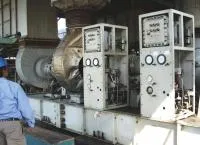
Upgrade the control system to give new life to old gas turbines
Gas turbines remain at the forefront of the power generation market, with a great variety available for the end-user in terms of unit size and fuel types.
However, due to the financial crisis and the rapidly expanding renewable energy market, the demand for new gas turbines has seen a marked decrease, since the mid 2000’s.
Rather than purchase newer turbines to replace their ageing fleet, gas turbine operators typically prefer to look at the range of options available, with a Control System retrofit being top of many operators lists when analyzing ways of extending the life of their turbine plant.
With such a huge number of gas turbines sold during the end of the 90s and the beginning of the 00’s, many of these turbine operators are faced with the realization that their control systems are no longer supported by the OEMs, and thus spare parts and technical assistance are both increasingly difficult to find and also increasingly expensive to acquire.
End-users who choose to fill their gaps in power production by importing older machines from overseas can also find that the existing control system does not meet the ever-increasingly tight regulation in place covering the Safety aspects of their local legislation, with the end result being a necessary replacement of the existing control scheme, or the ‘tacking-on’ of a separate Safety System to satisfy these regulations.
Considerations such as the systems overall Safety Integrity Level (SIL) can also play a very important factor in determining the choice of control system to be implemented on these retrofit systems.
Even for users where there is no specific requirement to adhere to a particular SIL level on a legal basis, it is increasingly found that their own internal analysis has determined that such a pre-determined SIL level should be achieved by the retrofit system.
The specific requirement for a control system retrofit should not be based purely on the SIL level achieved by the proposed system, however. Each turbine typically has a particular role to play in the end-users power generation strategy, and it is typically the level of criticality of the particular turbine that will determine the type of control system that is chosen to replace the existing scheme.
The over-riding parameter used for determining the suitability of a gas turbine control system retrofit package is the legal requirement for the package in terms of its Safety and Reliability record, if such a requirement exists. Clearly if the local or national legislation requires a SIL-3 compliant system, for example, before a connection to the grid can be made, then this must be provided irrespective of the end-users own requirements.
For a power plant such as an off-shore platform, where the loss of a turbine can result in huge financial losses, each turbine is typically considered to be ‘critical’, and the end user will try to find ways to minimise the possibility of the turbine being taken off-line by a failure of any device in the system, be it an actuator, switch, transmitter etc.
Older simplex systems typically have many individual points of failure, whereby the loss of any of these points will cause the turbine to trip. Modern dual-, triple- or even quad-redundant control systems attempt to minimise the possibility of unwanted turbine shutdowns by providing backup devices or voting schemes to minimise these spurious trips.
It is an oft-overlooked fact that a redundant control scheme is of little use unless the field devices that it interfaces with also have some redundancy. This is often implemented in the form of multiple-coil actuators, 2oo3 voting of transmitters etc.
There are many control systems available in the market, which are able to address these various requirements of end-users. At Tri-Sen, the gas turbine control system, a fully flexible, modular Gas Turbine Controller which can be configured in Simplex, Dual or Triple Redundancy, with both Dual- and Triple Redundant configurations, have been certified to SIL-3 for critical turbomachinery applications.
Thus, an end-user can utilize similar hardware for both critical and non-critical units in the same location, with a common operator interface and common spare parts.
The flexibility of the modular approach means that the system can be configured from a simple, single chassis for non-critical applications up to multiple-chassis applications for the most heavily instrumented turbine generator sets, with the following capabilities:
i) Aero-Derivative or Industrial
ii) Single, Dual or Multiple-fuels
iii) Fully automatic startup/shutdown sequence including turbine auxiliaries
iv) Gas turbine protection (flame failure, overspeed, exhaust overtemp etc.)
v) Automatic voltage regulator
vi) Automatic synchronization
vii) On-line Droop and Isochronous operation
Full Ethernet connectivity allows this modular control system to connect on any standard TCP/IP link for communication with a DCS, other components or 3rd-party units for load sharing.
As with providing state-of-the-art control systems for Gas Turbine retrofit solutions, Tri-Sen is committed to developing innovative solutions and other aspects of turbine Safety and Reliability by carrying out actuator upgrades, multiple speed pickup for redundancy, redundant I/H converters etc.



















 Advertise
Advertise






